|
|
|
 Tony's Astronomy Page
Tony's Astronomy Page 
Go here for the pictures I took in Germany during the total eclipse!
I am currently the proud owner of a Celestar 8 telescope. All
of the astronomical images that you'll find on my pages were taken using
this telescope and my digital camera. Here is an advertisement shot
of my telescope so that you know what it looks like. If you want
to see how it works internally then check the Astronomy
Additions page. I've had it for a little over a year now and I really
like it. I've had no problems and I'm planning on adding a CCD camera
in the near future so that I can get some really good pictures.
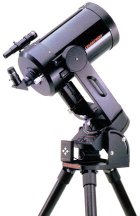
Here are some picture I took through my telescope with my digital camera.
I am using the same digital camera for these images as for all the vacation
pictures on the rest of the web site.
It is a Sony Mavica and it's a lot of fun. Although it is ideal for
normal photography, my astronomy images aren't that great. You can see
much more through the eyepiece than you can see in these pictures.
Currently, I just hold the camera up to the eyepiece and snap the image.
It doesn't allow me to focus very well and the camera isn't very light
sensitive. I can't even control the exposure time which is causing
the lack of color.

This next one is a shot of Jupiter that I took using the same camera.
Jupiter is much brighter and bigger but you can't tell that from the picture
because I only used my 25 mm lens. This results in a lower power
than you see in the shots of Saturn. I've used a photo editor (Paint
Shop Pro 5) to blow the image up. You can clearly see two of Jupiter's
moons on the left and you can barely see a third in the upper right just
above the arrow. Four were visible to the naked eye with the fourth
being on the upper right side of the planet about 1/3 rd the distance out
the the moon that is depicted with the arrow.
Here are a few images of the moon.. The moon comes out much better
than
the planets because it is much brighter. Compare these images to
the ones from the Web Cam that appear farther down the page.
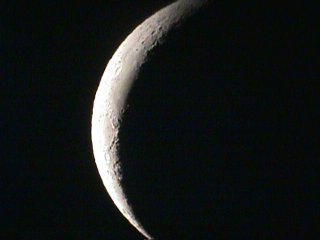
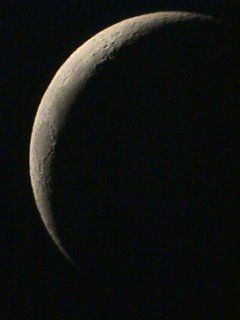
On our recent trip back to the United States from Germany I picked
up some new telescope equipment including a solar filter. What is
a solar filter for? Well, you can't look at the sun through a telescope
because the telescope will fry your eyeball like the proverbial ant under
a magnifying glass. A solar filter is like a pair of sunglasses for
your telescope. It cuts out 99.999% of the light so that you can
safely look at the sun. Note that it goes over the front of your
telescope to prevent the inside of your telescope from becoming overheated
and damaging the optics. Anyway, it looks like a big round mirror
that fits over the front of the telescope and this is what the sun looks
like through the filter. You can see the dark sunspot and a hazier
area around the sunspot. These spots are usually about the size of
the earth!

Here are a couple more sunspots but they aren't as concentrated as
the one above. I'm not quite sure about the physics behind sunspots
but I think they have something to do with plasma eruptions onto the suns
surface. They are usually associated with "prominences". Those
are the big, arching things that "splash" off the surface of the sun that
you've seen on TV. You can't see those with the type of solar filter
that I have. You need some sort of alpha hydrogen filter and they
cost more than my whole telescope. I don't see one of these in my
immediate future.
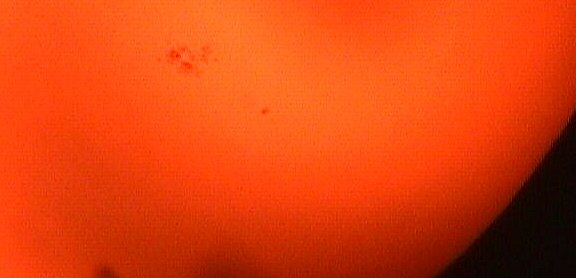
Here are a few pictures of Venus. Venus lies between the Sun
and the Earth so it goes through phases just like the moon. The outer
planets do this too but not nearly as much as the inner planets.
The inner planets go through the full phase cycle whereas the outer ones
just go through a very small partial phase. These shots are when
Venus is a little over half full. Venus is extremely bright since
it is so close to the Sun. I had to use some dark filters to get
these images. When I tried taking pictures without the filters they
were just big bright blobs in the camera. It was sort of like staring
into the bright headlights of an incoming car. Once I put on the
filter I got some good pictures.
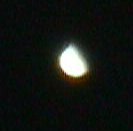
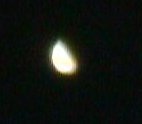
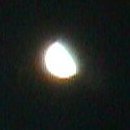
Taking pictures with the Sony Mavica is fun and easy but sometimes
it is hard to hold the camera, line it up with the eyepiece (especially
at high magnifications), use the "macro" focus, align the telescope and
snap the picture. I decided that there had to be something easier
and I decided that my web cam was the answer. I disassembled the
camera, used duct tape to attach it to an eyepiece and took some pictures.
It works pretty good but I still can't control the exposure time or color
very well. Also, the CCD chip (the electronic version of film) doesn't
have very many pixels so the resolution isn't very good. But I did
get some decent pictures of the moon that are a little farther down the
page.
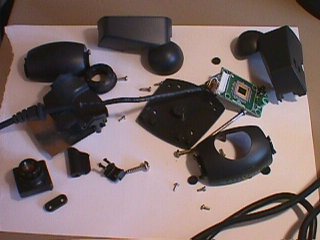
Here is a close-up shot of the CCD chip itself. It is very small.
The screw at the bottom of the picture is only 6 mm long which gives you
an idea of how small the chip is. If you would like to try this with
your own web cam then I encourage you to do so. But be careful!
Doing so will void your warranty and since the CCD chip is very prone to
damage from static electricity it is possible to damage your camera.
I suggest purchasing a grounding wrist strap from your nearest computer
store.
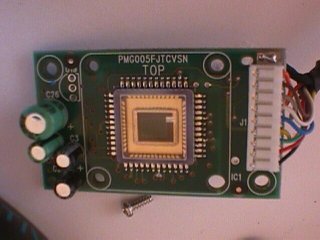
Here is the first picture that I took with the web cam. Once
I had it taped to the eyepiece I could easily pan around the surface of
the moon and take various pictures.
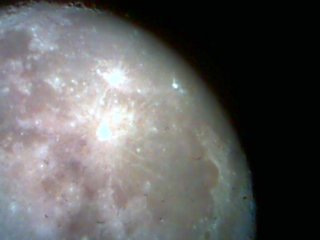
These shots are pretty good but you can do better with a real CCD camera
that was designed specifically for telescopes. I am planning on building
my own using the CCD Camera Cookbook. It tells you what to buy and
how to assemble your own CCD camera from parts that are available from
various stores. Once I start building the camera I will create a
page specifically for it. Unfortunately, I won't be building it while
I am here in Germany so it will have to wait until I go home to the states.
In the meantime I will try to get other images on this page as I take them.
I am hoping to get some good ones of the eclipse that will be visible over
here in August.
If you are interested in astronomy and space then you might be interested
in the Mars Society. This is a group that I belong to that is interested
in sending a manned mission to Mars. To make the return trip from
Mars the rocket will use fuel that it creates from the Martian atmosphere.
This saves a tremendous amount of weight because you don't have to carry
the fuel for the return trip with you when you blast off of the Earth.
Take a look at their home page and join them if you are interested.
![]()